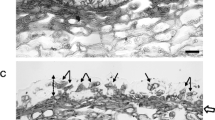Abstract
Effects of the gibberellins A4+7(GA4+7) and A3(GA3), benzyladenine (BA) and forchlorfenuron (CPPU) on deposition of the cuticular membrane (CM) in developing tomato (Lycopersicon esculentum L.) fruit were investigated. Growth regulators were applied when fruit development within trusses ranged from the flower to the mature stage. Developmental stage of fruit at the time of application was indexed by fruit diameter. Fruit were harvested at maturity, the CM isolated enzymatically on an individual fruit basis and mass of CM per unit fruit surface area calculated. In mature fruit, mass of CM per fruit increased with fruit size, but mass of CM per unit surface area was independent of fruit size, position within a truss and position of the truss on the plant. GA4+7 and GA3 increased CM mass per unit fruit surface area at concentrations up to 300 mg l−1. Young fruit (5–10 mm diam. at time of application) was most responsive. Responsiveness decreased as fruit development at application progressed towards maturity. There was no consistent effect of GA4+7 or GA3 on fruit mass. BA (up to 100 mg l−1) or CPPU (up to 3 mg l−1) had no significant effect on CM mass per unit surface area regardless of developmental stage. Higher concentrations of BA or CPPU decreased CM mass per unit surface area. There was no effect of BA or CPPU on fruit mass. Potential mechanisms and benefits of a gibberellin induced increase in CM deposition are discussed.





Similar content being viewed by others
Abbreviations
- CM:
-
Cuticular membrane
- BA:
-
Benzyladenine
- CPPU:
-
Forchlorfenuron
- GA:
-
Gibberellin
- PGR:
-
Plant growth regulator
References
Baker EA, Bukovac MJ, Hunt GM (1982) Composition of tomato fruit cuticle as related to fruit growth and development. In: Cutler DF, Alvin KL, Price CE (eds) The plant cuticle. The Linnean society symposium series no. 10. Academic Press, New York, pp 33–44
Bakker JC (1988) Russeting (cuticle cracking) in glasshouse tomatoes in relation to fruit growth. J Hort Sci 63:459–463
Batal KM, Weigle JL, Lersten NR (1972) Exogenous growth-regulator effect on tomato fruit cracking and pericarp morphology. J Amer Soc Hort Sci 97:529–531
Borve J, Sekse L, Stensvand A (2000) Cuticular fractures promote postharvest fruit rot in sweet cherries. Plant Dis 84:1180–1184
Bowen DJ, Walton TJ (1988) Cutin composition and biosynthesis during gibberellic-acid induced stem extension of Pisum sativum var. Meteor. Plant Sci 55:115–127
Glenn GM, Poovaiah BW (1989) Cuticular properties and postharvest calcium applications influence cracking of sweet cherries. J Amer Soc Hort Sci 114:781–788
Goren R, Monselise SP, Ben Moshe A (1976) Control of corky (silvery) spot of grapefruit by growth regulators. Hort Sci 11:421–422
Goudriaan J, Monteith JL (1990) A mathematical function for crop growth based on light interception and leaf area expansion. Ann Bot 66:695–701
Greene DW (1993) Effects of GA4 and GA7 on flower bud formation and russet development on apple. J Hort Sci 68:171–176
Hoffmann-Benning S, Kende H (1994) Cuticle biosynthesis in rapidly growing internodes of deepwater rice. Plant Physiol 104:719–723
Jeffree CE (1996) Structure and ontogeny of plant cuticles. In: Kerstiens G (ed) Plant cuticles. Environmental plant biology series. BIOS Scientific Publishers Ltd., Oxford, pp 33–82
Knoche M, Beyer M, Peschel S, Oparlakov B, Bukovac MJ (2004) Changes in strain and deposition of cuticle in developing sweet cherry fruit. Physiol Plant 120:667–677
Kolattukudy PE (1981) Structure, biosynthesis, and biodegradation of cutin and suberin. Ann Rev Plant Physiol 32:539–567
Peschel S, Knoche M (2005) Characterization of microcracks in the cuticle of developing sweet cherry fruit. J Amer Soc Hort Sci 130:487–495
Reuveni M, Sheglov D, Rulf R (2001) The influence of fungicides and gibberellin (A4+7) applications on russet control of ‘Golden Delicious’ apple fruit. J Hort Sci Biotechnol 76:636–640
Steenkamp J, Westraad I (1988) Effect of gibberellin A4+7 on stem- and calyx-end russeting in ‘Golden Delicious’ apples. Scientia Hort 35:207–215
Williams MH, Vesk M, Mullins MG (1989) Characteristics of the surface of banana peel in cultivars susceptible and resistant to maturity bronzing. Can J Bot 67:2154–2160
Williams MH, Vesk M, Mullins MG (1990) Development of the banana fruit and occurrence of the maturity bronzing disorder. Ann Bot 65:9–19
Acknowledgements
We thank Valent BioSciences Corporation for funding this research, Peter D. Petracek for stimulating discussions and Björn Schorch for his interest and technical help in the study.
Author information
Authors and Affiliations
Corresponding author
Rights and permissions
About this article
Cite this article
Knoche, M., Peschel, S. Gibberellins Increase Cuticle Deposition in Developing Tomato Fruit. Plant Growth Regul 51, 1–10 (2007). https://doi.org/10.1007/s10725-006-9107-5
Received:
Accepted:
Published:
Issue Date:
DOI: https://doi.org/10.1007/s10725-006-9107-5




